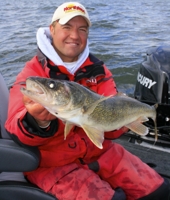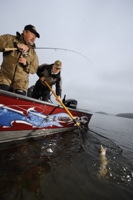Livebait Plus Boat Control Equals Virtual Walleye Invincibility
Feb 28th, 2011 by OutdoorsFIRST
Modified Feb 28th, 2011 at 12:00 AM
I’d hate to fathom a guess at the number of big walleyes that have crossed the gunwales of Lund boats. It wouldn’t be easy to calculate the number of tournaments won in these famed fishing vessels, either. Or for that matter, trying to estimate how many 5 to 10-pounders my uncle Gary has boated over the years. Hundreds surely, though numbers are probably in the thousands. Of all those big fish and all of his tournament wins, a major percentage of them have been driven by masterful boat control while properly presenting livebait.
By itself, lively bait holds the zeal and appeal to put loads of fish in the net. Likewise, skilled boat control will, on its own merit, keep your hook perpetually inside the fish zone. But combine the two into a singular system, and you’ll be boating hawgs, snapping photos and winning tournaments. Think boat control doesn’t make that much of a difference? Guess again.
Quality livebait plus skilled boat control equals near invincibility. Boat control is everything when it comes to maximizing efforts. Sonar units are so good these days that given enough time, anyone can locate walleyes and keep track of them. And that’s a key first step. But staying on fish is the skill that separates anglers like Mr. Walleye from the others. It takes continual practice, and precision operation of your electric motor, kicker outboard and main engines, with eyes ever attuned to sonar, GPS and an underwater camera. The boat itself is equally as fundamental to the system, too.
 |
|
| Author and professional fishing guide Tony Roach, hoodwinks big walleyes by skillfully controlling his boat to hold a vertical position over the fish, keeping livebait continuously in their faces. Photo courtesy of Lund Boats (www.lundboats.com) |
It’s no accident that Gary and the best walleye anglers in North America run the boats they do. You’ve heard of certain cars that “hug the road.” That’s a pretty apt description for the way Lund boats interact with the surface of the water. It’s exactly why we chose our boats-a Pro-V for Gary, and a Pro Angler for me. The hulls on these boats are simply more “fishable” than anything else on the water. I’ll yield to the engineers on things like freeboard, reverse chine and IPS2 hulls. All I know is that when wind and waves really start rockin’, I can maneuver the transom upwind, hunker down and stay locked on a spot while other boats get blown off course.
There’s a lot of talk today about precision trolling for suspended fish, too, as well as casting crankbaits and swimbaits to shallow walleyes in cover. Both can be awfully entertaining and effective methods, each requiring their own methods of boat control. But even today while discussions about livebait, rigging and jigging doesn’t seem to be as cool or in “vogue”, the simple truth is that most of us still catch the majority of our walleyes using old-school approaches. And it’s simply because walleyes still stack in relatively deep water and must be approached vertically with livebait.
There are two things I know for sure: If you put any two anglers throwing artificial lures in shallow water up against Gary Roach backtrolling livebait on deep structure, Mr. Walleye is going to win 9 times out of 10. Second, if you can learn to position and hold your boat steadily above a specific piece of underwater turf, or even just hold at a precise depth along a steep breakline that’s holding fish, you’ll go home with walleyes in your livewell more often than not.
One of the most enjoyable ways to catch walleyes is hunting individual fish with sonar, and then put my Lund to work while tempting the fish with a luscious minnow, nightcrawler or leech. So it goes: Cruising along the outer edge of a broad point, my sonar paints two beautiful arches within a foot of the bottom in 24-feet of water. Even before sonar is finished drawing the image, I’ve done some multitasking, punching in a waypoint while shifting to neutral and then reverse with the motor to hold position directly above the fish. I have also snatched up a nearby rod, pre-set with a Roach Rig-slip-sinker, InvisaSwivel, and a fluorocarbon leader snelled to a #6 octopus hook. From inside my baitwell or a Frabill Aqua-Life Bait Station, I dip a super-frisky live chub or shiner, or perhaps a leech depending on the bite. Within the space of five seconds, I’ve got bait working its magic in the face of those two whoppers.
Observing direction of the prevailing wind, I’ll point the boat directly into the blow-bow-mount electric in light wind, backtrolling in gusts. I never take my eyes off the sonar or my waypoint, either. I want to stick directly above the fish so that the sonar shows an almost continuous line-fish kept below the transducer signal. Ideally, I also want to be able to monitor my sinker, as I use my rod tip to alternatively pick it up and set it gently back on the bottom. In major rough seas, or when fish are on the move, this isn’t always feasible, but it’s my goal. And if nothing else, I want to maintain a near 90-degree line angle, assuring that my bait is directly beneath the hull.
 |
|
| Lund Legend Tom Neustrom, another advocate of total boat control, tames a walleye with Mr. Walleye, Gary Roach. Photo by Bill Lindner Photography |
No doubt, making this happen is a major function of experience. But mostly it’s those learned abilities to observe and use wind to your advantage while making continuous neutral, reverse and sometimes forward adjustments with your motors. Think of yourself like an ace Coast Guard helicopter pilot whose skills require you to drop a rescue basket on individual targets. With practice, the technique can be learned.
Done right, your bait stays within that dangerous walleye zone. The inevitable result is a major boost in the number of strikes. As you gain experience and skill, you’ll notice other boats around you drifting right through clusters of walleyes, their baits in front of fish for mere seconds before slipping off structure and into empty water.
Make sure to give ’em a friendly wave as they drift away from what’s become your own personal school of fish.